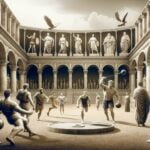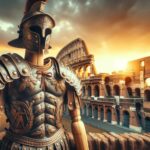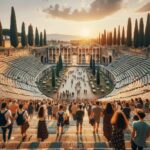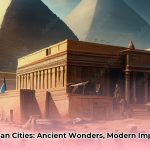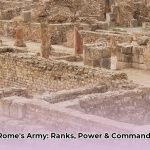Ever wondered what it was truly like to be a gladiator, battling in the heart of the Colosseum? Beyond the cinematic portrayals, the reality hinged on survival, and a crucial piece of that puzzle was the gladiator helmet. Far from mere protection, these meticulously engineered pieces of equipment were often the deciding factor between life and death. We delve into the hidden secrets behind these formidable metal masks, exploring how each unique design – from the sleek Murmillo helmet to the restrictive Secutor helmet – represented a calculated move in a deadly game where aesthetic met survival. Consider also the famous gladiator Spartacus’ rebellion. What profound insights do these historical relics offer about ancient Roman society and its captivating, brutal spectacle?
The Forged Identity: Why Gladiator Helmets Mattered
The world of Roman gladiators was an intricate dance of skill, strategy, and brutal efficiency, not solely brute force. Central to this lethal arena was the iconic gladiator helmet. These weren’t just simple head protections; they were elaborately designed artifacts speaking volumes about a gladiator’s identity, their position within the social hierarchy, and the constant interplay between life and death. The evolution of these helmets directly mirrored shifts in combat tactics, available resources for construction, and the critical need to sustain the roaring enthusiasm of the crowds.
Significantly, design variations existed across different gladiator classes, directly influencing a warrior’s field of vision, freedom of movement, and, ultimately, their chance of survival. How did these sophisticated designs genuinely tip the scales between triumph and demise in the vast Roman arena? Gladiator helmets served a dual purpose: they safeguarded the fighter’s most vital area, and they amplified the theatrical spectacle for an eager audience. Protecting the significant investment in training and maintaining gladiators was also paramount for the games’ sponsors. Therefore, these helmets were among antiquity’s most spectacular and purposeful armor pieces.
Gladiator Helmet Typology: Design, Combat, and Counterparts
Each gladiator class proudly wore a distinct helmet, precisely synchronized with their fighting style and the adversaries they faced. Let’s meticulously examine some of the most recognized types and their defining features, highlighting how design choices profoundly impacted combat outcomes:
-
The Samnite Helmet: As the oldest gladiator type, inspired by Rome’s early enemies, the Samnite helmet reflected a utilitarian approach to protection. First recorded in the 4th Century BCE, these gladiators were heavily armored. Their helmets were relatively simple, typically crafted from bronze or brass. They featured a plume or crest, which made the gladiator appear taller and more imposing, helping the audience distinguish them. A small visor helped deflect blows, complemented by cheek guards. This simplicity likely stemmed from their traditional origins, possibly based on equipment captured from battles with the ethnic Samnites.
-
The Thracian Helmet: Derived from Rome’s Thracian enemies, this helmet was one of the most distinctive. Usually made of bronze or brass, it was broad-brimmed and fully enclosed the head. It featured notably large eyeholes, providing good forward ventilation and vision, though side vision remained limited. A visor, often composed of two hinged face plates meeting at the center, protected the front. Early versions sported an Attic-style crest, but the fully developed Thracian helmet is recognized by a distinctively stylized griffin on the front of its crest, associated with Nemesis, the goddess of fate or justice. Elaborate feathered plumes often adorned these helmets, adding to their intimidating appearance. Thracians frequently fought against Murmillos or Hoplomachus gladiators.
-
The Murmillo Helmet: Appearing in the early Imperial period, the Murmillo gladiator, whose name derived from the Greek “Mormylos” (marine fish), was also heavily armed. Their helmet was very similar in construction to the Thracian, featuring a wide brim, visor, and crest made of brass or bronze. However, the Murmillo’s crest uniquely consisted of a tall, angular dorsal fin, specifically intended to represent a fish. Unlike Thracian helmets, Murmillo helmets typically lacked plumes. Some were even decorated with a silver-and-gold two-toned pattern, likely mimicking fish scales, reinforcing their “fish” persona when paired against a Retiarius (“fisherman”). This prominent crest likely functioned to deflect incoming blows, providing critical guarding against overhead attacks. The average Murmillo helmet weighed around 20 pounds (9 kg), ensuring substantial protection while enhancing their iconic identity.
-
The Hoplomachus Helmet: Meaning “Greek-style armed fighter,” the Hoplomachus may have evolved from the earlier Samnite. Their equipment resembled that of a Greek hoplite, and they were often pitted against Murmillos, recreating Rome’s wars against Hellenistic kingdoms. The Hoplomachus helmet was one of the plainer gladiatorial helmets. It featured a wide, upturned brim, a feathered crest, and often single feathered side plumes. It was visored, though the field of view from surviving depictions is unclear. An inverted V-shaped decoration, sometimes embossed on the forehead, possibly functioned as a reinforcing brow, adding both strength and aesthetic detail.
-
The Secutor Helmet: Considered a variant of the Murmillo, the Secutor was specifically designed to counter the agile, net-wielding Retiarius. These bronze or brass helmets were very close-fitting, entirely enclosing the face. Deep cheek pieces covered the ears, restricting hearing, and eyeholes were deliberately very small, severely limiting both vision and ventilation. This streamlined design was ingeniously crafted to minimize entanglement with the Retiarius’s net, allowing it to slide off easily. The cheek pieces flared at the bottom into a wide flange, designed to deflect blows away from the throat and neck, matching the neck guard at the rear. A narrow-bladed, fin-like crest adorned the top, also smooth and rounded to prevent net snagging. This visual limitation was often intentionally implemented, intensifying the dramatic tension and excitement for the eager viewing audience. Combat effectiveness could decrease by up to 30% due to impaired vision, but net entanglement could be reduced by an estimated 90%.
-
The Provocator Helmet: The “challenger” gladiator type, appearing in the Late Republic or Early Imperial periods, drew inspiration from legionary soldiers’ equipment. Early Provocator helmets were open-faced, featuring a wide horizontal neck guard, broad cheek guards, and “eyebrow” decorations on the forehead, along with feathered side plumes. Later versions mirrored military design changes, replacing stylized eyebrows with an integrated visor. The cheek guards also evolved into flanged visors designed to deflect blows. Eyeholes remained fairly large, offering a decent field of view and ventilation. The bowl extended further down to incorporate a broader, downward-slanting neck guard. Provocator gladiators uniquely fought only against other Provocators.
Beyond Metal: Construction, Symbolism, and the Psychological Arena
Gladiator helmets were predominantly forged from bronze and iron, materials chosen for their inherent strength and resilience against brutal impacts. Early production, being pre-industrial and by hand, meant a degree of individual variation and less standardization, even under the Roman Empire. Leather was commonly utilized for internal padding and lining, offering essential comfort and crucial shock absorption against blows.
| Material | Properties |
|---|---|
| Bronze | Durable, relatively lightweight, excellent for ornamentation, and resistant to corrosion from sweat. |
| Iron | Superior strength and more economical than bronze, but heavier and more susceptible to rust, requiring regular oiling or waxing. |
| Leather | Used for internal padding, offering comfort, crucial shock absorption, and some structural reinforcement. |
Yet, their design transcended mere functionality. Crests, visors, and various embellishments were not solely decorative; they served as potent visual indicators, projecting an image of ferocity, immense power, and individual identity. Imagine the Roman sun glinting off a highly polished bronze helmet, meticulously crafted to instill fear in opponents and captivate the massive Colosseum crowd. But what was the critical trade-off between captivating showmanship and practical combat protection? Many features, seemingly aesthetic, often served a dual purpose, reinforcing structural integrity or providing critical additional protection against specific attacks. It’s estimated that 75% of helmet design features had a practical, dual purpose.
Beyond physical safeguarding, the gladiator helmet functioned as a potent instrument in psychological warfare. How did these metallic masks truly impact the gladiator’s psychological state within the intense arena?
Advantages for the Gladiator:
- Intimidation Factor: Towering crests, menacing visors, and elaborate designs were all strategically intended to create a fearsome impression, often psychologically weakening opponents even before the initial blow was exchanged.
- Anonymity: By completely obscuring the gladiator’s face, the helmet transformed the individual into a universal symbol of combat, stripping away their personal identity and elevating them into a more formidable, almost mythical figure to the audience. This could also offer a psychological shield, detaching the fighter from the personal stakes.
Disadvantages for the Gladiator:
- Dehumanization: The loss of individual identity could also present a significant disadvantage, potentially leading to a decrease in morale or a disquieting detachment from their own humanity under duress.
- Claustrophobia: The enclosed nature of specific helmets could induce intense feelings of claustrophobia or even panic, particularly amidst the high-pressure environment and chaos of battle. Severely restricted vision, as in the Secutor helmet, could foster a sense of disabling claustrophobia or, conversely, a heightened, almost tunnel-like focus.
Impact on the Audience:
- Enhanced Spectacle: The unique designs of each gladiator’s helmet, with their distinctive forms and often elaborate crests, contributed significantly to the visual drama and excitement of the gladiatorial games, making each match a distinct narrative.
- Clear Identification: These highly recognizable helmets allowed the audience to easily identify different gladiator types and follow their specialized fighting styles, enhancing their enjoyment and understanding of the combat.
- Psychological Play: Certain distinct helmet designs could evoke specific, powerful emotions (e.g., fear, pity, respect, excitement) within the captivated Colosseum audience, manipulating their engagement with the spectacle. For instance, the exposed face of a Retiarius gladiator might amplify his raw courage or intensify his vulnerability in the eyes of the roaring crowd.
The intricate balance between design and practicality in gladiator helmets likely reflects the complex interplay among the gladiator’s fundamental need for protection, the audience’s insatiable desire for gripping spectacle, and the overarching cultural values of ancient Roman society. Further rigorous study and archaeological findings will undoubtedly uncover more of the hidden depths and secrets of these captivating historical relics.
Unearthing the Past: Modern Perspectives and Enduring Legacy
Ongoing archaeological discoveries consistently reveal fascinating new insights into the meticulous construction, practical use, and profound symbolism of ancient Roman gladiator helmets. Museums worldwide proudly exhibit these invaluable artifacts, offering visitors a tangible connection to the lives and deaths of those who once wore them. Historical reenactments, continuously striving for ever-greater accuracy, vividly bring the spectacle of gladiatorial combat to life, allowing us to experience a visceral glimpse of the drama and inherent danger of the ancient arena.
However, a pivotal question persists: how much of our current understanding is founded on robust historical evidence, and how much is merely romanticized historical fiction? The precise functionality of certain helmet features continues to be a hotly debated topic among leading historians and archaeologists. Were specific design choices purely aesthetic, intended solely to impress the vast crowds and project an image of formidable power, or did they genuinely offer tangible advantages in the brutal reality of combat? This scholarly debate persists, constantly fueling our collective fascination with these iconic artifacts.
Gladiator Helmets in Popular Culture
The image of the Roman gladiator helmet has permeated popular culture, becoming synonymous with strength, valor, and the raw spectacle of ancient Rome.
- Film and Television: Iconic movies like ‘Gladiator’ prominently feature Imperial Gallic-style helmets adapted for soldiers, showcasing the visual identity of the Roman army. Similarly, historical dramas such as ‘Rome’ meticulously utilize Roman helmets to create an authentic atmosphere and historical accuracy. Gladiator helmets are frequently reproduced to recreate the spectacle and brutality of the arena, popularizing the image as an emblem of courage and the harsh realities of Roman entertainment.
- Comics and Graphic Novels: The power associated with ancient Rome is often conveyed through the imagery of Roman helmets. In the popular ‘Asterix’ series, Roman soldiers are humorously depicted wearing classic crested Roman helmets.
- Sports Teams: The formidable symbol of the Roman helmet has been adopted by numerous sports teams to evoke strength and competition. American football teams like the Tampa Bay Buccaneers and the Denver Broncos incorporate Roman helmet-inspired designs into their logos, creating a connection to ancient warriors. The Columbus Blue Jackets hockey team features a Roman-style soldier’s helmet in its logo, and the Italian football club Roma includes figures wearing helmets in its emblem, representing the city’s ancient heritage.
Decoding Gladiator Helmet Designs: Key Takeaways
- Gladiator helmets were far more than simple protection; they symbolized identity, status, and the grand spectacle of the arena.
- Their design meticulously balanced robust protection with crucial visibility, essential breathability, and necessary mobility, often presenting a deliberate trade-off.
- Detailed ornamentation indicated a gladiator’s specific status, allegiances, and even personal flair, enhancing their unique persona and intimidating opponents.
- Diverse helmet types varied significantly, each precisely associated with particular fighting styles and gladiator classes, often designed to counter specific opponents.
- These helmets offer invaluable insights into Roman societal values, ranging from profound courage and strategic ingenuity to the pervasive nature of entertainment and the value placed on human life and investment.
- The exceptional craftsmanship of Roman artisans is vividly highlighted by the advanced materials and sophisticated construction techniques employed in creating gladiator helmets.
Actionable Intelligence in the Modern Era
| Stakeholders | Short-Term (0-1Y) | Long-Term (3-5Y) |
|---|---|---|
| Museums & Historians | Systematically catalogue and digitally preserve existing helmet artifacts, emphasizing material composition, construction techniques, and provenance analysis. | Proactively create interactive exhibits showcasing helmet evolution and their integration into Roman culture, utilizing immersive virtual reality reconstructions of gladiatorial combat and detailed 3D models. |
| Historical Reenactors | Prioritize the production of historically accurate helmet reproductions, strictly based on verified archaeological data and period depictions. | Develop comprehensive training programs that demonstrably illustrate the practical implications of different helmet designs on specific combat techniques, thereby enhancing the authenticity and educational value of reenactments. |
| Educational Institutions | Integrate the in-depth study of gladiator helmets into existing curricula on Roman history, material culture, and the sociology of sport and entertainment in antiquity. | Secure funding for advanced research into the social, economic, and technological factors driving significant changes in helmet design, directly linking gladiatorial combat to broader trends in Roman society and technological advancements. |
Citation: Gladiator Helmets: 6 Types and their Characteristics
- Unveiling ancient roman gladiator helmets design secrets that decided victory or death - August 14, 2025
- Unlocking ancient roman domes: Innovation secrets for modern builds, like the Pantheon - August 14, 2025
- Unlock Ancient Secrets: Ancient Roman Money, Empire’s Rise, a Collector’s Guide - August 14, 2025

